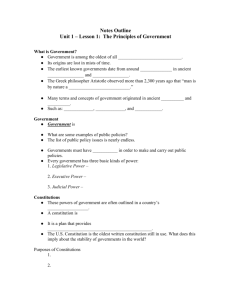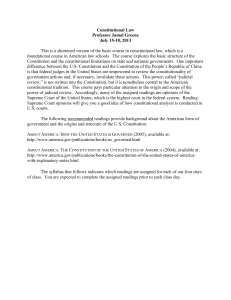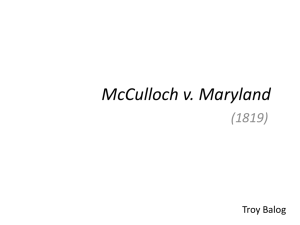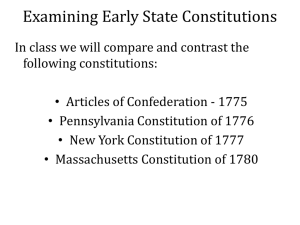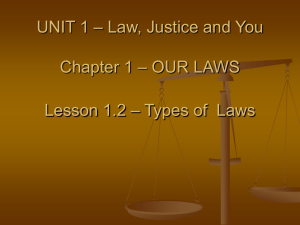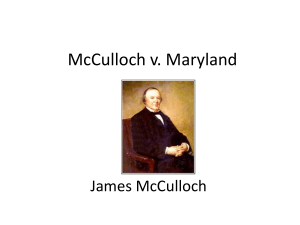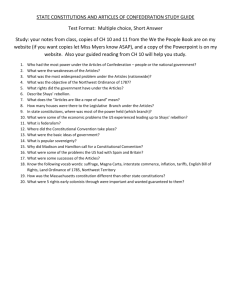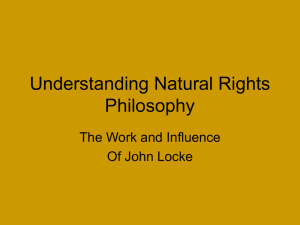Document
advertisement
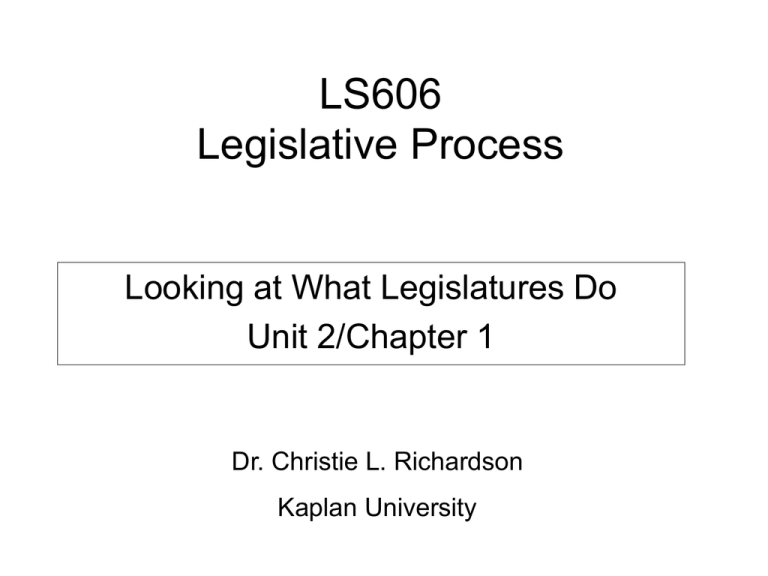
LS606 Legislative Process Looking at What Legislatures Do Unit 2/Chapter 1 Dr. Christie L. Richardson Kaplan University Spheres of Sovereignty • Dual constitutionalism – – – – Establish roles and responsibilities of government Define institutional structure Establish operational procedures Spell out rights of citizens • James Madison (Federalist No. 45) stated that, “The powers delegated by the proposed Constitution to the Federal Government are few and defined. Those which are to remain to the State Governments are numerous and indefinite.” Different from U.S. Constitution • State constitutions reveal a strong suspicion of government power. • State constitutions act as a roadblock to change. – Should be brief and to the point. – Establish a basic framework. – Should be receptive to orderly change. • Strong movement to pass constitutional amendments aimed at increasing power. Amending State Constitutions • Formal changes – Legislative Proposals • Available in all 50 states. It is the most common form of change. – Constitutional Ballot Initiatives and Referendums • Can be used in 18 states – Constitutional Conventions • Oldest method for delegates to meet to amend or completely rewrite state constitutions. – Constitutional Revision Commissions • Available in all 50 states • Formed to study and make recommendations for change. – Ratification Why State Constitutions Vary • Vitality – States - education, health care, and welfare – Local Government - policing, controlling, illegal drugs • Political Culture – States - traditionalist in the South, moralistic in the North, individualistic in the Midwest – Local Government - culture will flourish in cities that have business centers Why State Constitutions Vary • Population Shifts – States - gains in the Sunbelt, losses in the Great Plains, little change in the Midwest and Northeast regions of the country – Local Government - Gains in the Sunbelt cities, large losses in many of the Midwest cities • Legal Documents – States - Constitutions prescribe the structure of state government – Local Government - Cities and counties are legal creatures of the states by controlling the kinds of charters they can have. Constitutional and Legal Limits on State Action • U.S. Constitution limits what the states can do. • Ex Post Facto Laws – Prevents a person from being punished for an action that was not a crime when it was committed. • Tenth Amendment to the U.S. Constitution – Powers not given to the federal government, nor denied to the states, are reserved to the states, or to the people.” – Amendment rediscovered in the 1990s – It is consistently a factor when federal intrusion into state affairs becomes an issue. • McCulloch v. Maryland, 17 U.S. 316 (1819) McCulloch v. Maryland 17 U.S. 316 (1819) Basis of Federal Power • Facts – In 1816, Congress chartered The Second Bank of the United States. In 1818, the state of Maryland passed legislation to impose taxes on the bank. James W. McCulloch, the cashier of the Baltimore branch of the bank, refused to pay the tax. • Issues – Did Congress have the authority to establish the bank? – Did the Maryland law unconstitutionally interfere with congressional powers? • Decision (7 to 0) – The Court held that Congress had the power to incorporate the bank and that Maryland could not tax instruments of the national government employed in the execution of constitutional powers. – Chief Justice Marshall noted that Congress possessed unenumerated powers not explicitly outlined in the Constitution. – Marshall also held that while the states retained the power of taxation, "the constitution and the laws made in pursuance thereof are supreme. . .they control the constitution and laws of the respective states, and cannot be controlled by them." Conclusion • State constitutions provide the border and the foundation. • Reflect and reveal variation across states, which must provide continuity, in order to be the United States • Provide an additional outlet for citizen participation through government elections, exercising constitutional rights, and to move from one state to another freely. References • Kernell, S., Jacobson, G. C., & Kousser, T. (2012). The logic of American politics. (Fifth ed.). Los Angeles, CA: CQ Press. • McCulloch v. Maryland,17 U.S. 316 (1819). Retrieved from http://www.oyez.org/cases/1792-1850/1819/1819_0. • Nowak, J. E., & Rotunda, R. D. (2010). Principles of constitutional law. (Fourth ed.). St. Paul, MN: Thomson Reuters. • Rosenthal, A. (2004). Heavy lifting: the job of the american legislature. Washington, DC: CQ Press. • Saffell, D. C., & Basehart, H. (2009). State and local government: Politics and public policies. (Ninth ed.). Boston, MA: McGraw-Hill Higher Education.
